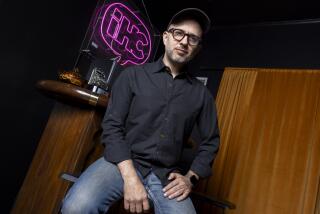House of Dues, Paid
- Share via
Step back in time to Los Angeles three years ago and what do you see? A long line of schmoozers trying to get into the Foundation Room. We’re referring (of course) to the art-heavy room upstairs at the art-gilded House of Blues, where everyone who was anyone could be seen each night.
Those who were at the Sunset Strip nightclub in West Hollywood during its early years know we’re not exaggerating. The Foundation Room was like an E-ticket to stargazing: Madonna, Prince, Bruce, Clapton. Rock star royalty turned out and, in turn, Hollywood movers and shakers were there to do some gazing themselves. It was madness.
The club was on fire, and chaos ensued. Despite putting on some great shows--it opened with Aerosmith--the House of Blues made a lot of initial mistakes. The industry guest list often put the 1,000-seat club over capacity, and members of the G.P.--the general public, the people who actually paid for their tickets--couldn’t get into shows and had to be refunded. These are folks who hired the baby-sitter, got dressed up and, ultimately, wound up with no place to go.
Meanwhile, the club had too many managers and lots of confusion about who actually had jurisdiction over what realm. Simply trying to figure out what door you were supposed to enter was like playing some twisted variation of “Let’s Make a Deal.” Hmmm, let’s see if the tickets are behind door No. 3. . . . Nope. OK, let’s try door No. 1. Uh-oh.
Lastly, it might have been cheap back then to use valet parking (now it costs $10), but you’d better not have been in a hurry. Somehow, it always took about 45 minutes for them to find your vehicle.
The bottom line: There were so many logistic hurdles that it was difficult to even notice that beyond all the confusion, something was happening onstage. Aah, that’s if you could see the stage. Diners discovered that unless they had a table near the second-floor railing, the stage was not visible.
Fast-forward to ’97. Beyond all the hype and cynicism that accompanied its launch, the House of Blues has proved to be a viable, valuable entity on L.A.’s music scene. The vision of former Hard Rock Cafe co-founder Isaac Tigrett, with investors ranging from Harvard University to the estate of River Phoenix, the club has worked out most of its kinks. (The Kinks have even played here.)
Once things cooled down at the venue, the folks who ran it were able to take a breath and begin the tough task of selling 1,000 tickets each night. So they turned up the volume and the emphasis on the music, and despite the venue’s name, they’ve transformed it into the most eclectic music club in L.A. Bookings range from qawwali music to Israeli pop, from rockabilly to rock en espan~ol, from blues to ska, from cow punk to classic rock. The club books hard-core rap, something few L.A. clubs are willing to do.
By its second year, the club had broken even. The shows sell well: Last month, there were nine sellouts in a row, all without major headliners.
“The competition in L.A. is pretty intense, and no one knew what to make of us at first,” says Kevin Morrow, vice president of tours and talent for the club. “It’s taken us three years to get people to understand what we are, which is an eclectic showcase for all kinds of music.”
Coming shows illustrate the range: roots rockers the lasters (Saturday), keyboardist Keiko Matsui (Sunday), bluesman R.L. Brunside (Wednesday) and Japanese punk trio Shonen Knife (May 17).
Morrow credits newcomer John Pantle, his former assistant and now the club’s co-talent buyer, for keeping the music fresh and interesting. “It’s tough meeting all of L.A.’s musical needs in relation to the city’s diversity,” says Pantle, a former member of the Aquabats. He also ran the club Music City in Fountain Valley, which featured early performances by Beck, Reel Big Fish and the Smoking Popes. “But I try to keep our image within the perimeters of general excellence; the bottom line is, the music’s got to be good.”
BE THERE
House of Blues, 8430 Sunset Blvd., West Hollywood, (213) 848-5100. Age limit varies, cover varies.
More to Read
The biggest entertainment stories
Get our big stories about Hollywood, film, television, music, arts, culture and more right in your inbox as soon as they publish.
You may occasionally receive promotional content from the Los Angeles Times.










